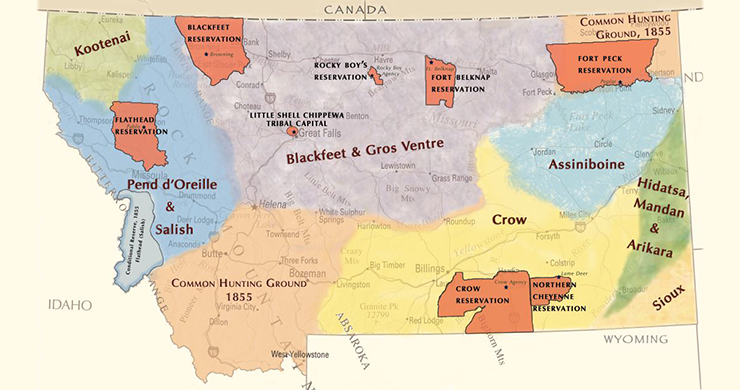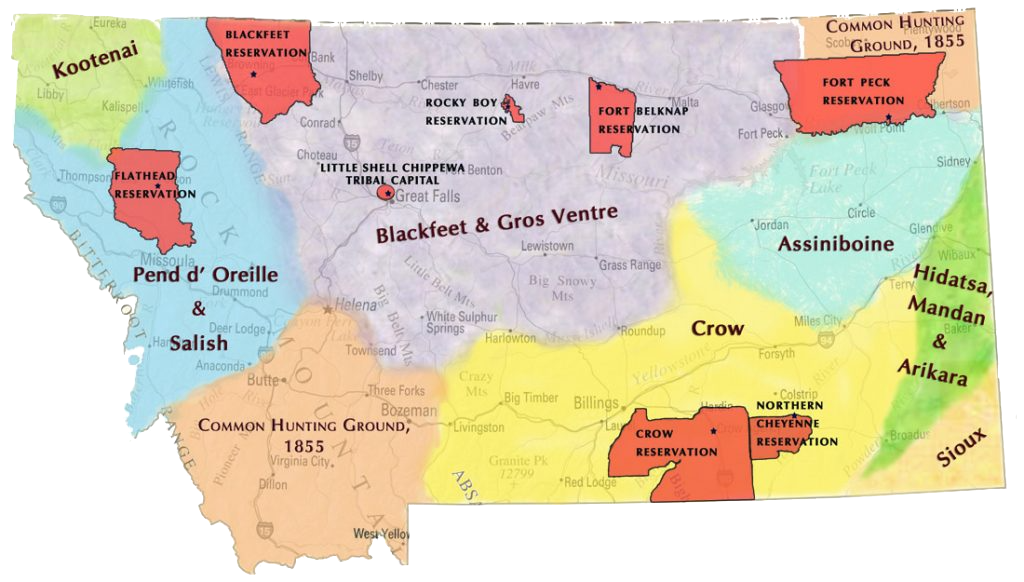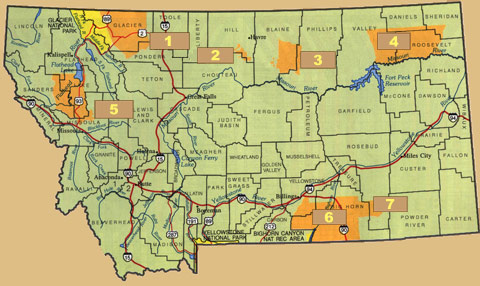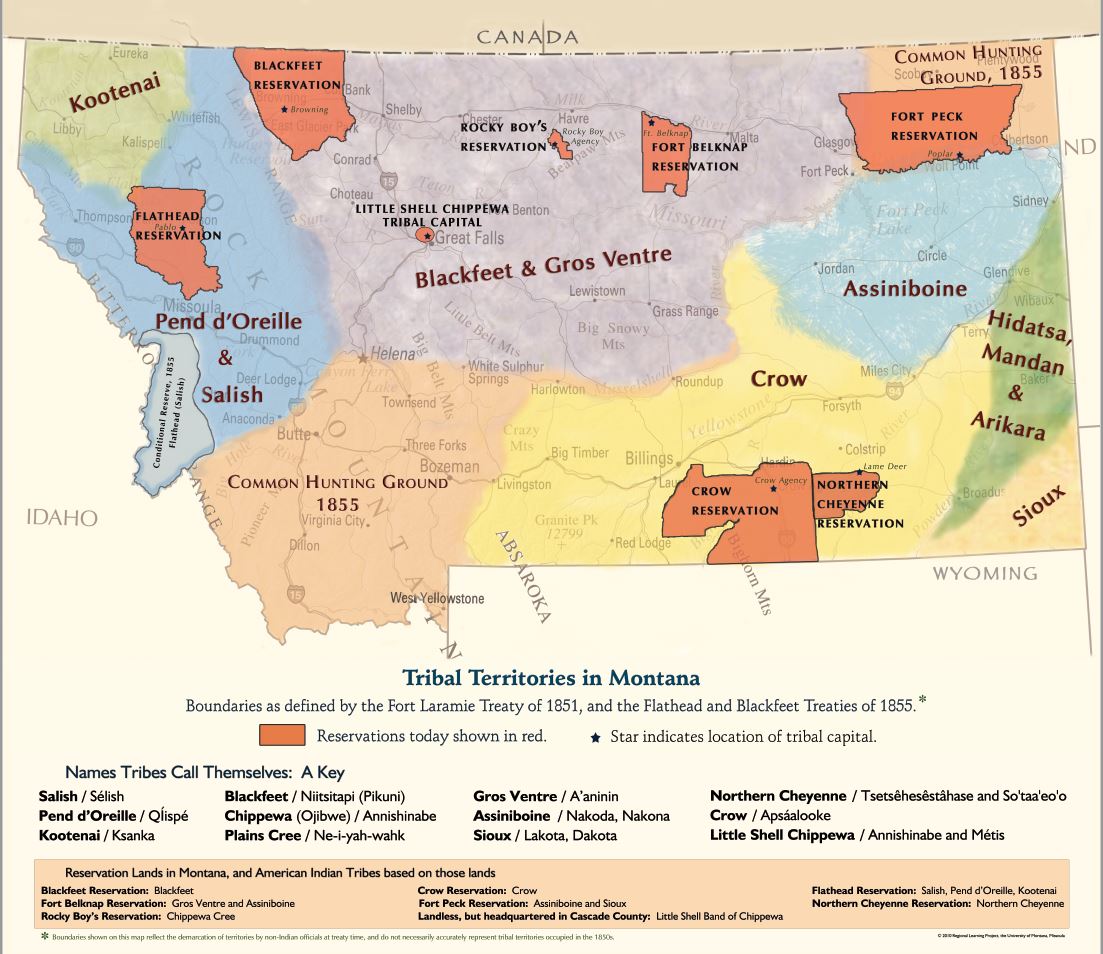
The Living Map: A Deep Dive into Montana’s Native American Reservations
Montana. The "Big Sky Country." A land of vast landscapes, rugged mountains, and sweeping prairies. While often romanticized for its natural beauty and cowboy lore, a deeper, more profound history is etched into its very geography: the story of its Indigenous peoples. A map of Montana’s Native American reservations isn’t merely a static representation of land; it’s a living document, a testament to resilience, sovereignty, and enduring cultural identity. For any traveler or history enthusiast seeking to understand the true spirit of this state, comprehending this map is essential.
This article will navigate the intricate layers of history, identity, and contemporary life found within Montana’s seven major Native American reservations, offering a vital context for respectful engagement and genuine understanding.
The Historical Canvas: A Land Before Borders

Before the arrival of European settlers, the lands now known as Montana were a vibrant mosaic of distinct Indigenous nations. The Blackfeet, Crow, Northern Cheyenne, Salish, Kootenai, Pend d’Oreille, Gros Ventre, Assiniboine, Sioux, and Cree peoples, among others, thrived here for millennia. Their lives were intimately connected to the land – following buffalo herds, managing vast hunting territories, practicing sophisticated agricultural techniques, and engaging in extensive trade networks that spanned the continent.
These were not homogenous groups, but diverse societies with unique languages, spiritual beliefs, governance structures, and artistic traditions. The Blackfeet, fierce warriors and expert buffalo hunters, dominated the northern plains. The Crow, known for their elaborate horse culture and strategic prowess, held sway in the Yellowstone River basin. The Salish and Kootenai, dwelling in the western mountains, practiced a more sedentary lifestyle, relying on fishing, gathering, and hunting. The landscape itself was their map, marked by sacred sites, ancestral trails, and seasonal camps – a complex, dynamic system of land use utterly unlike the rigid lines that would soon be imposed.
The Genesis of Reservations: Treaties, Trauma, and Resilience
The mid-19th century brought an irreversible shift. The relentless westward expansion of the United States, fueled by the Homestead Act, the discovery of gold, and the construction of transcontinental railroads, led to increasing conflicts over land and resources. The era of treaty-making began, often under duress and characterized by profound power imbalances. Treaties, ostensibly agreements between sovereign nations, frequently resulted in the ceding of vast ancestral lands in exchange for promises that were rarely kept.

The "reservation" system emerged as a federal policy designed to confine Native American tribes to specific, often diminished, territories, ostensibly to protect them but more often to clear the way for white settlement. This process involved forced removals, brutal military campaigns (like the "Indian Wars"), and the systematic destruction of traditional ways of life, most notably the slaughter of the buffalo herds that sustained many Plains tribes.
The Dawes Act of 1887 further eroded tribal land bases by breaking up communally held lands into individual allotments, with the "surplus" land often sold off to non-Native settlers. This policy aimed to assimilate Native Americans into mainstream American society by dismantling tribal structures and promoting individual land ownership, but it largely resulted in poverty, land loss, and the fragmentation of communities.
Despite these immense pressures and profound injustices, the spirit of Montana’s Indigenous peoples never broke. They adapted, resisted, and, crucially, preserved their cultures, languages, and identities, laying the groundwork for the sovereign nations that exist today.
A Geographical & Cultural Odyssey: Montana’s Seven Sovereign Nations
Montana’s contemporary map showcases seven distinct Native American reservations, each a testament to a unique history and a vibrant present. Understanding them individually reveals the depth of their collective story.
1. Blackfeet Nation (Pikuni)
- Location: North-central Montana, bordering Glacier National Park and Canada. Its agency town is Browning.
- Tribes: Primarily the Pikuni (Southern Blackfeet), one of the four bands of the Blackfoot Confederacy (Siksikaitsitapi).
- History & Identity: The Blackfeet have a deep spiritual connection to the land, particularly the Rocky Mountains and the vast plains, which were central to their buffalo hunting culture. Their reservation was established through a series of treaties and agreements in the late 19th century, drastically reducing their ancestral territory. Today, the Blackfeet Nation is the largest reservation in Montana by population.
- Cultural Highlights: Known for their rich ceremonial life, including the Sun Dance, and their strong emphasis on language preservation. The Museum of the Plains Indian in Browning offers a profound insight into their history and art.
- Contemporary Life: The Nation actively manages its natural resources, including oil and gas, and is deeply involved in cultural tourism, leveraging its proximity to Glacier National Park. They face challenges related to economic development but are fiercely proud of their heritage and sovereignty.

2. Crow Nation (Apsáalooke)
- Location: South-central Montana, south of Billings, encompassing parts of the Yellowstone River basin. Its agency town is Crow Agency.
- Tribes: Apsáalooke (Crow).
- History & Identity: The Crow, historically known for their expert horsemanship and strategic alliances, secured a relatively large reservation through the Fort Laramie Treaty of 1868. Their land encompasses historical sites, including the Little Bighorn Battlefield National Monument (though the battlefield itself is federal land, it’s culturally significant to the Crow).
- Cultural Highlights: The Crow Fair Celebration, held annually in August, is one of the largest and most vibrant Native American gatherings in the country, showcasing traditional dances, rodeo, and a teepee village. The Crow language remains strong.
- Contemporary Life: The Crow Nation is actively involved in resource management, particularly coal, and is working to diversify its economy. They maintain strong traditional governance and cultural practices, emphasizing education and language revitalization.
3. Northern Cheyenne Reservation (Tsétsêhéstâhese)
- Location: Southeastern Montana, south of Forsyth and west of Ashland. Its agency town is Lame Deer.
- Tribes: Tsétsêhéstâhese (Northern Cheyenne).
- History & Identity: The Northern Cheyenne’s history is one of extraordinary resilience. After the Sand Creek Massacre and forced relocation to Indian Territory (Oklahoma), a band of Cheyenne led by Dull Knife and Little Wolf made a desperate, epic journey back to their homeland in 1878-79. Their determination led to the establishment of their reservation in 1884, a rare instance where a tribe successfully fought for a reservation in their desired homeland.
- Cultural Highlights: The Northern Cheyenne maintain strong spiritual traditions and ceremonies. Their language is a vital part of their identity.
- Contemporary Life: The Nation focuses on cultural preservation, sustainable development, and addressing social challenges. They are active in advocating for tribal sovereignty and self-determination.
4. Fort Belknap Indian Reservation
- Location: North-central Montana, south of Harlem and west of Malta. Its agency town is Fort Belknap Agency.
- Tribes: Aaniiih (Gros Ventre) and Nakoda (Assiniboine).
- History & Identity: This reservation is unique in that it was established for two distinct, historically allied tribes. Formed in 1888 from a portion of the vast Great Northern Reservation, it consolidated the Aaniiih and Nakoda peoples.
- Cultural Highlights: Both tribes maintain their distinct languages and cultural practices while sharing a common governance structure. They are known for their buffalo herd and efforts in cultural and ecological restoration.
- Contemporary Life: The Fort Belknap Tribes are focused on economic development, education, and health services. They actively work on land stewardship and cultural revitalization, including buffalo reintroduction programs.
5. Fort Peck Indian Reservation
- Location: Northeastern Montana, stretching from Wolf Point to Poplar. It is the second-largest reservation in Montana by area.
- Tribes: Dakota (primarily Yanktonai, Sisseton, and Hunkpapa Sioux) and Nakoda (Assiniboine).
- History & Identity: Established in 1888, the Fort Peck Reservation became home to various bands of Dakota and Nakoda peoples, many of whom were displaced from other areas or were survivors of the conflicts of the late 19th century. It boasts the largest Native American population in Montana.
- Cultural Highlights: The reservation is a vibrant center for powwows and traditional ceremonies. Language preservation efforts are critical for both Dakota and Nakoda languages.
- Contemporary Life: The Fort Peck Tribes are deeply engaged in economic development, including oil and gas, agriculture, and gaming. They face challenges associated with rural poverty but are committed to improving education and healthcare for their members.
6. Rocky Boy’s Indian Reservation
- Location: North-central Montana, south of Box Elder and west of Havre.
- Tribes: Ne-i-yah-wahk (Chippewa Cree) and a band of Little Shell Chippewa.
- History & Identity: Rocky Boy’s is the youngest reservation in Montana, established in 1916. It was created for landless Chippewa and Cree bands, including descendants of Chief Little Shell, who had been displaced and marginalized for decades. Its formation was a hard-won victory for these "landless Indians."
- Cultural Highlights: The reservation is known for its strong Métis (mixed Cree and European ancestry) cultural influence, traditional arts, and ceremonies.
- Contemporary Life: The Rocky Boy’s Tribe is dedicated to self-sufficiency, economic growth, and cultural preservation. They have developed successful enterprises and are focused on improving the quality of life for their community members.
7. Flathead Reservation (Confederated Salish and Kootenai Tribes – CSKT)
- Location: Western Montana, encompassing much of Flathead Lake and the Mission Mountains. Its agency town is Pablo.
- Tribes: Ql̓ispé (Pend d’Oreille), Séliš (Salish), and Ktunaxa (Kootenai).
- History & Identity: The Flathead Reservation was established by the Hellgate Treaty of 1855, which consolidated the Salish, Kootenai, and Pend d’Oreille tribes onto a portion of their ancestral lands. Over time, significant portions of the reservation were allotted and sold to non-Native settlers, particularly around Flathead Lake.
- Cultural Highlights: The CSKT are renowned for their sophisticated tribal government and their commitment to language and cultural revitalization. They host annual celebrations and maintain traditional hunting and fishing practices.
- Contemporary Life: The CSKT are a model of tribal self-governance and economic diversification. They manage natural resources, including hydroelectric dams, timber, and water rights (a landmark water compact was ratified in 2021). They operate a tribal college and are leaders in environmental stewardship.
Beyond the Borders: Shared Identity & Enduring Challenges
While each reservation possesses a unique identity, shared threads connect them. All are sovereign nations within the United States, meaning they have inherent rights to self-governance, jurisdiction over their lands, and the ability to establish their own laws and institutions. This sovereignty, though often challenged and misunderstood, is the bedrock of their continued existence and self-determination.
However, the legacy of colonization, forced assimilation, and broken treaties continues to manifest in significant socio-economic disparities. Many reservations grapple with higher rates of poverty, unemployment, lower life expectancies, and inadequate access to healthcare and education compared to the general population. The trauma of historical injustices, including the residential school system that sought to strip children of their culture, echoes through generations.
Yet, despite these profound challenges, the story of Montana’s Native American reservations is ultimately one of immense strength, resilience, and cultural resurgence. Tribal governments are tirelessly working to rebuild their economies, revitalize their languages, preserve their sacred traditions, and reclaim their narratives. They are innovators in sustainable resource management, leaders in cultural education, and powerful advocates for Indigenous rights on both local and national stages.
Visiting with Respect and Purpose
For travelers and history enthusiasts, understanding this living map of Montana’s Native American reservations opens doors to profound learning experiences. When visiting, it is crucial to do so with respect, humility, and an open mind:
- Respect Sovereignty: Remember you are entering a sovereign nation. Familiarize yourself with tribal laws and customs.
- Seek Permission: For events, ceremonies, or visiting specific sites, inquire about appropriate protocols. Photography may be restricted.
- Support Local Economies: Purchase goods and services from tribal enterprises, artists, and businesses.
- Learn and Listen: Visit tribal museums, cultural centers, and attend public events (like powwows, if invited and appropriate). Engage with stories and perspectives directly from tribal members.
- Be Mindful: Be aware of the historical context and ongoing challenges. Avoid making assumptions or perpetuating stereotypes.
The map of Montana’s Native American reservations is far more than just lines on paper. It represents ancestral homelands, enduring cultures, and vibrant communities. It tells a story of survival against immense odds, a testament to the unwavering spirit of Indigenous peoples. By engaging with this map, not just as geography but as a living history, we gain a richer, more accurate understanding of Montana and, indeed, of America itself. It is an invitation to witness resilience, celebrate diversity, and honor the nations that have shaped, and continue to shape, this remarkable land.

